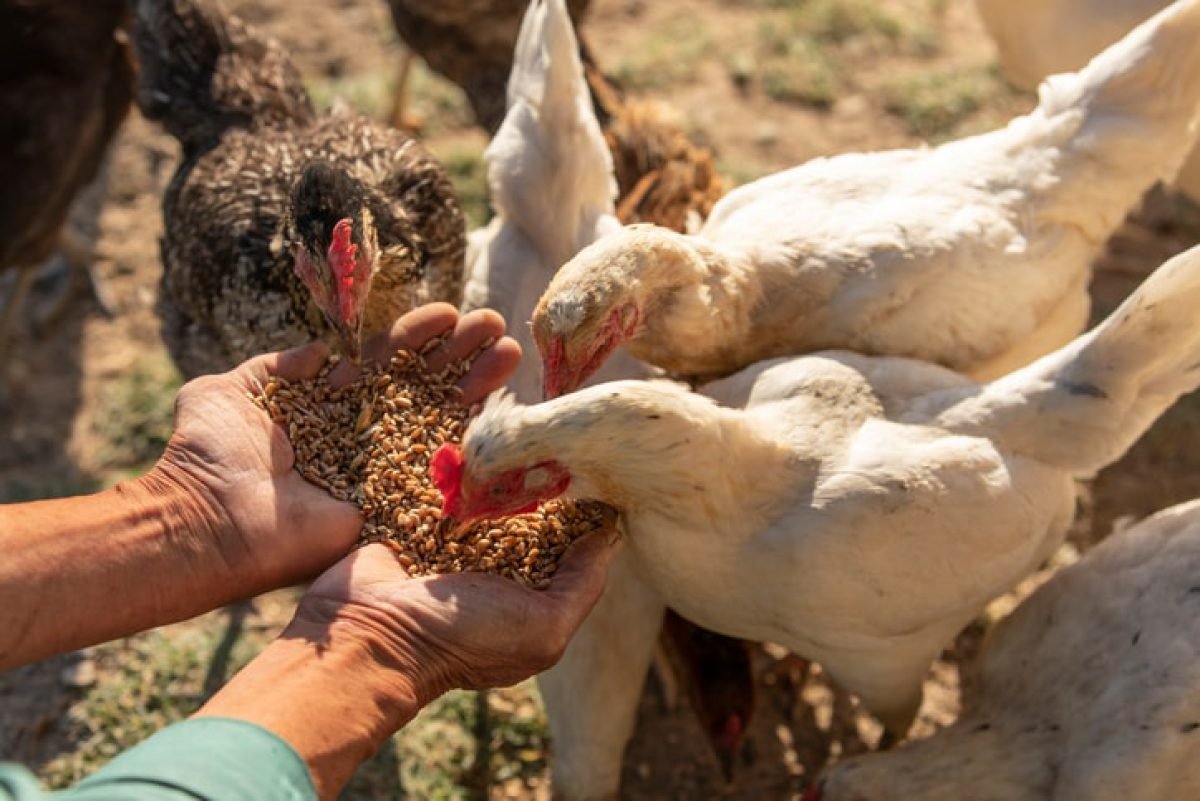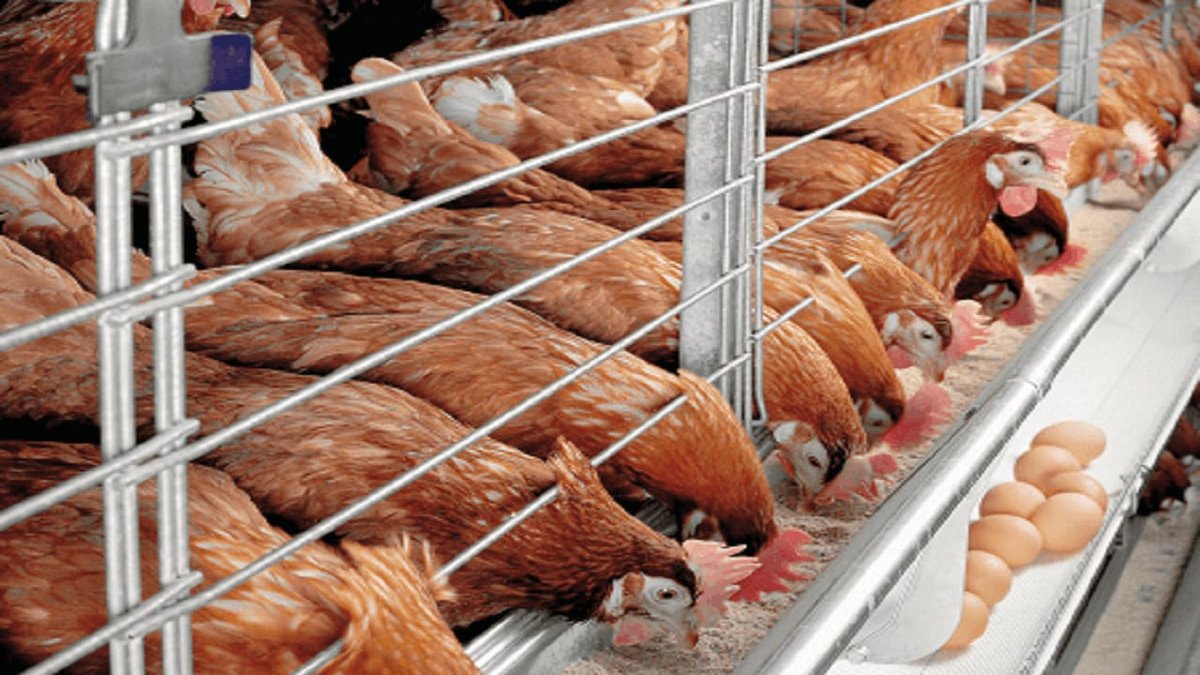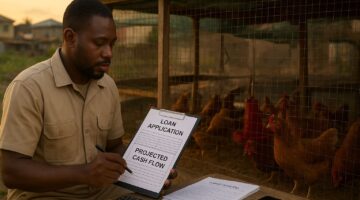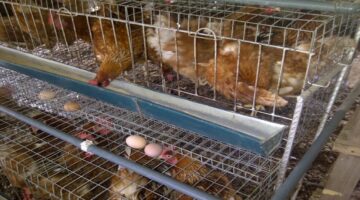Are you a poultry farmer in Nigeria trying to figure out exactly how many bags of feed for broilers you need? You are not alone. Guessing your feed requirements is a sure way to lose money, either by buying too much feed that goes to waste or by not buying enough, which makes your birds grow poorly. This uncertainty about feed requirements costs Nigerian farmers a lot of money and can be very frustrating.
Knowing the right amount of feed helps you budget properly, ensures your chickens reach market weight on time, and makes your entire poultry farming business more profitable. This guide complements our comprehensive guide on starting a profitable poultry business in Nigeria, focusing specifically on the feed calculation aspect. This guide will solve that problem for you. We will break down exactly how to calculate feed for broiler chickens, from their first day until they are ready for sale at 6 weeks.
We will cover everything from the standard feeding chart for broilers to the cost of feeding 100 broilers in Nigeria. By the end of this guide, you will know precisely how much starter, grower, and finisher feed to buy, taking the guesswork out of your broiler feeding program. Let’s make your poultry venture a success.
Note: All statistics and financial figures in this guide are estimates based on standard industry benchmarks and may vary based on your specific location, broiler breed, feed brand, and farm management practices.
Section 1: Quick Answer Summary Table: How Many Bags of Feed for Broilers?
For farmers who need a quick answer for planning and budgeting, here is a simple table showing the approximate total number of 25kg bags of feed required to raise different flock sizes of broilers for a full 6-week cycle. This table is a great starting point, but remember that the detailed sections below are crucial for ensuring accuracy and maximizing your profit. For example, a common question is how many bags of feed for 25 broilers for 6 weeks are needed? The answer is 5 bags. Another is how many bags of feed for 50 broilers for 6 weeks? The answer is 10 bags.
| Number of Broilers | Total Bags of Feed (25kg) Needed (Approximate) |
|---|---|
| 20 Broilers | 4 Bags |
| 25 Broilers | 5 Bags |
| 50 Broilers | 10 Bags |
| 100 Broilers | 19 – 20 Bags |
| 500 Broilers | 96 Bags |
Note: These are estimates based on industry standards. Feed intake can vary slightly based on the broiler breed (e.g., Cobb 500 vs. Ross 308), the quality and energy levels of the feed, and your specific farm management practices, including handling heat stress, Heat stress can lead to secondary issues like respiratory infections in chickens, making proper feed management even more critical. For instance, if you are asking how much feed do I need for 50 chickens, the table gives you a clear answer, while the detailed sections help you understand the variables.
In summary, this quick-reference table gives you a fast estimate for your initial feed purchase. Now that you have a general idea about how many bags of feed for broilers, let’s dive into the specific calculations for each growth phase to understand exactly how we arrived at these numbers and how you can tailor them to your farm.
Interactive Broiler Feed Calculator – Customize for Your Farm
Now that you’ve seen the general estimates in our quick reference table, let’s calculate the exact feed requirements for YOUR specific flock. This calculator answers your specific question: how many bags of feed for broilers do I need based on my unique situation?
Why Use This Calculator?
Every farm is different. This calculator factors in:
- Your exact flock size – Whether you’re raising 20 or 500 birds
- Current local feed prices – Input today’s prices from your supplier
- Expected mortality rate – Nigerian average is 3-5%, but yours may differ
- Your preferred bag size – While 25kg is standard, some suppliers offer 50kg bags
Result: A precise budget tailored to your farm’s specific needs, helping you avoid both overbuying and underbuying feed.
How to Use This Calculator:
- Enter your number of broilers – This is the number of day-old chicks you’re starting with
- Adjust the mortality rate – Use your farm’s historical data (new farmers can use 5%)
- Update the feed prices – Call your local feed supplier for current prices or use our estimates
- Confirm your bag size – Most Nigerian suppliers use 25kg bags, but verify with your supplier
- Click “Calculate” – Get instant results showing total bags needed and cost breakdown
Broiler Feed Calculator
A powerful tool to plan your broiler feed and budget with dynamic pricing.
Flock Details
Your Feed Prices
Understanding Your Calculator Results
The calculator above uses the same industry-standard consumption rates detailed in our comprehensive guide below. Here’s what the results mean for your farm:
- Total Bags Needed: This is the minimum number of bags you’ll need for the entire 6-week cycle. We recommend buying 1-2 extra bags as a buffer.
- Phase-Specific Requirements: Notice how Finisher feed represents the largest portion? This is normal as birds eat more as they grow.
- Cost Per Bird: This helps you determine your break-even selling price. Add other costs (chicks, vaccines, utilities) to get your total cost per bird.
- Mortality Adjustment: The calculator factors in gradual mortality throughout the 6 weeks, giving you a more realistic estimate than simple calculations.
Next Steps: Now that you know exactly how many bags of feed for broilers you need, continue reading below to learn about feed management best practices, how to reduce wastage, and when to switch between feed types.
Section 1.5: The Broiler Feeding Phases: An Overview with Visual Guide
To get the best results and ensure your chickens grow to their full potential, you must understand the three distinct phases of a broiler’s life. Each phase requires a different type of feed specifically formulated to meet the changing nutritional needs of the birds as they grow.
Phase 1: The Starter Phase (Week 1 to 2)
This is the most critical period. The feed is rich in high-quality protein (22−24%) and essential vitamins to help the chicks develop strong bones, organs, and a robust immune system. This phase lays the foundation for all future growth. Think of this as building a strong frame for a house before you add the walls and roof. Without a good starter phase, your broilers will never reach their full potential. The feed should be in a fine crumble or mash form to make it easy for the tiny chicks to eat. This phase is critical for starting profitable broiler farming in Nigeria as it sets the foundation for your entire production cycle.
Phase 2: The Grower Phase (Week 3 to 4)
During this phase, the goal shifts to rapid muscle and weight gain. The feed has a slightly lower protein content (20−22%) but a higher energy level. This allows the birds to grow quickly and efficiently, preparing them for the final push to market weight. The feed is typically provided as a pellet to encourage higher consumption and reduce wastage. A popular question is when to switch from chick starter to grower for broilers? The answer is at the start of week 3. The transition should be gradual, mixing the two types of feed over a period of 2-3 days to avoid digestive upsets.
Phase 3: The Finisher Phase (Week 5 to 6)
The finisher feed is designed to put the final weight and fat on the birds. It has the lowest protein content (18−20%) but is packed with energy to ensure a good feed conversion ratio (FCR). This means the birds convert the feed into weight more efficiently, which is key to maximizing your profit. By week 5, the broiler’s digestive system is mature, and it can handle a less digestible, higher-energy feed. This final push is what helps you get the best market price for your birds.
Understanding these three phases is the first step in creating a successful feeding plan. Now, let’s dive into the detailed calculations for each phase.
Section 2: Detailed Broiler Feed Calculator by Growth Phase
To get the best results and achieve your target market weight efficiently, you cannot feed your broilers the same type of feed for 6 weeks. Their nutritional requirements change dramatically as they grow.
The broiler feeding program is typically split into three phases: Starter, Grower, and Finisher. Under normal conditions, a single broiler will eat approximately 4.8 kg of feed over 6 weeks to reach a market weight of about 2.8 kg. So, how to calculate feed for broiler chickens during each crucial phase? Here’s how.
The Critical Starter Phase (Week 0 – Week 2)
This is the foundation of your broiler’s life. The starter feed has the highest protein content (typically 22-24%) to help the chicks develop strong frames, healthy organs, and a robust immune system. Getting this phase right is non-negotiable for good final weight.
- Duration: 14 days (2 weeks)
- Feed Type: Broiler Starter, usually in “mash” or “crumbles” form. Crumbles are often preferred for day-old chicks as they are easier to pick up, leading to less wastage.
- Average Feed Consumption per Bird: A broiler chick will typically consume about 0.54 kg of starter feed during this period. (This is an estimate.)
- Calculation Example (for 100 Broilers):
- Total Starter Feed: 100 birds × 0.54 kg/bird = 54 kg
- Bags Needed (25kg): 54 kg ÷ 25 kg/bag = 2.16 Bags (You would need to buy 3 bags to be safe).
The Rapid Growth Grower Phase (Week 3 – Week 4)
During the grower phase, the focus shifts from frame development to rapid muscle and weight gain. The feed has a slightly lower protein content (20-22%) but is very high in energy. This is when you switch from chick starter to grower feed.
Continuing with starter feed would be too expensive and not optimized for the best weight gain. A popular question is when to switch from chick starter to grower for broilers? The answer is at the start of week 3.
- Duration: 14 days (2 weeks)
- Feed Type: Broiler Grower, often in pellet form to encourage higher intake.
- Average Feed Consumption per Bird: Each broiler will generally require 1.6 kg of grower feed. (This is an estimate.)
- Calculation Example (for 100 Broilers):
- Total Grower Feed: 100 birds × 1.6 kg/bird = 160 kg
- Bags Needed (25kg): 160 kg ÷ 25 kg/bag = 6.4 Bags (You would buy 7 bags).
The Finishing Phase for Market Weight (Week 5 – Week 6)
The finisher feed is all about getting the birds to their final market weight. It is designed to help the birds add more flesh and fat. It has the lowest protein content (18-20%) but the highest energy levels. This feed composition ensures an excellent feed conversion ratio, meaning more weight for less feed, which is key to your profit margin.
- Duration: 14 days (2 weeks), or until the birds reach your target weight.
- Feed Type: Broiler Finisher, usually in pellet form.
- Average Feed Consumption per Bird: On average, a broiler will eat 2.65 kg of finisher feed. (This is an estimate.)
- Calculation Example (for 100 Broilers):
- Total Finisher Feed: 100 birds × 2.65 kg/bird = 265 kg
- Bags Needed (25kg): 265 kg ÷ 25 kg/bag = 10.6 Bags (You would buy 11 bags).
What If You Want to Raise Broilers Beyond 6 Weeks?
Some markets, especially during festive seasons, prefer bigger birds (3kg+). To achieve this, you may need to raise your broilers for 7 or 8 weeks. If so, you will continue feeding them Finisher feed.
- Week 7: A broiler will eat approximately 1.6 kg of finisher feed. (This is an estimate.)
- Week 8: A broiler will eat approximately 1.7 kg of finisher feed. (This is an estimate.)
Remember, the FCR gets less efficient as birds get older, meaning it costs you more in feed for every extra kilogram of weight they gain. You must calculate if the higher sale price for a bigger bird justifies the extra feeding cost.
In summary, breaking down your feed plan into these three phases is essential for both the health of your birds and your budget. Knowing the exact bags per phase prevents last-minute trips to the market. Now, let’s look at a week-by-week feeding chart that will help you monitor your flock’s progress like a professional.
Section 3: Standard Feeding Chart for Broilers (Daily & Weekly)
This section answers the question, what is the standard feeding chart for broilers? The standard feeding chart for broilers is a powerful management tool that helps you track your flock’s weekly feed consumption and growth to ensure they are on target.
To manage your feed effectively, it’s helpful to know the feed intake per bird on a weekly basis. This chart is more than just a guide; it is a powerful tool to monitor your flock’s health and performance. It also helps you answer the question, how many bags of feed for broiler per day will be needed in each week, which is crucial for daily management.
| Age of Broiler | Feed Per Bird (This Week) | Total Feed So Far (Per Bird) | Target Body Weight |
|---|---|---|---|
| Week 1 | 167 grams | 167 grams | 185 grams |
| Week 2 | 375 grams | 542 grams | 465 grams |
| Week 3 | 650 grams | 1.19 kg | 940 grams |
| Week 4 | 945 grams | 2.14 kg | 1.5 kg |
| Week 5 | 1.22 kg | 3.35 kg | 2.2 kg |
| Week 6 | 1.43 kg | 4.79 kg | 2.8 kg |
Note: All values in this chart are estimates and may vary based on your specific flock and management practices.
This chart shows that feed consumption increases every week. By the end of week 6, a single broiler will have consumed a total of about 4.8 kg of feed.
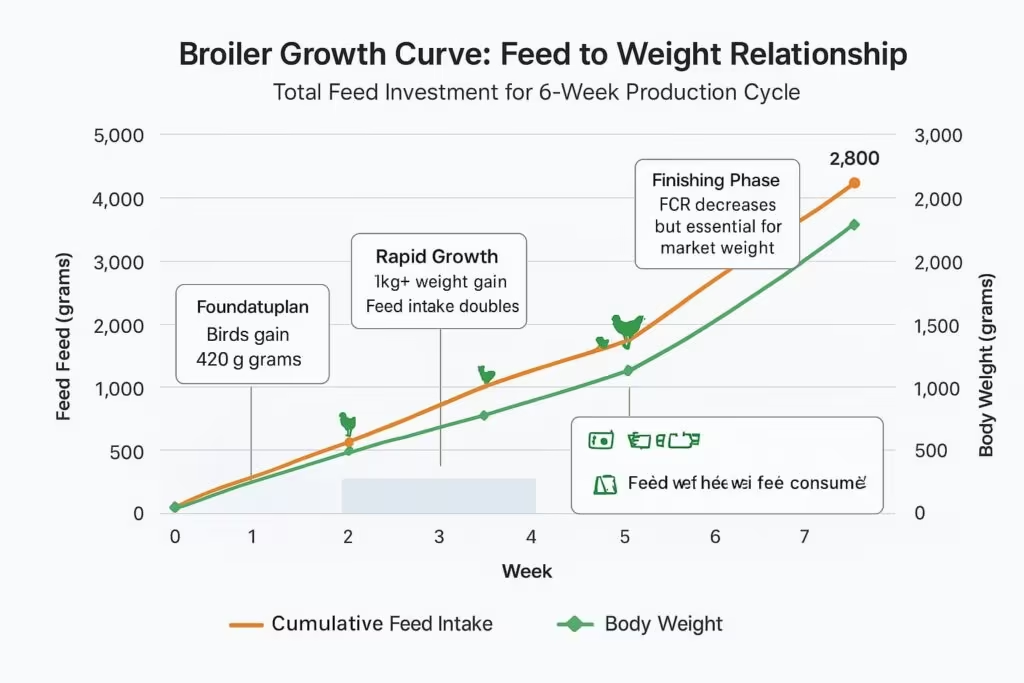
How to Use This Chart to Spot Problems
This chart is your early warning system. If you notice your birds are eating significantly less than the amount listed for a particular week, it could be a sign of a problem like:
- Illness: Reduced appetite is one of the first signs of disease.
- Heat Stress: During hot weather, birds eat less.
- Poor Water Quality: If water is dirty or too warm, birds won’t drink enough, and therefore won’t eat enough.
- Poor Feed Quality: The feed may be stale or mouldy.
Troubleshooting: A Diagnostic Flowchart for Low Feed Intake
If you notice your flock is consuming less than 80% of the expected feed for their age, use this step-by-step troubleshooting guide to diagnose the problem.
- Check Water Supply & Temperature:
- Action: Ensure your birds have constant access to fresh, clean, and cool water. During hot periods, add ice to the waterers.
- Reasoning: Birds drink at least twice as much water as they eat. If water is warm or dirty, they will not drink, which directly affects their appetite.
- Assess Environmental Conditions:
- Action: Check the temperature and ventilation of the poultry house. If it’s hot, improve airflow by opening curtains, using fans, or misting the roof.
- Reasoning: Broilers eat less when they are stressed by heat. A well-ventilated house is essential to prevent this.
- Inspect Feed Quality:
- Action: Look for signs of mold, strange smells, or caking in the feed. If you have been storing it for a while, it may have gone stale.
- Reasoning: Poor-quality or contaminated feed is unpalatable and can cause illness, leading to reduced intake.
- Observe Bird Health & Behavior:
- Action: Carefully check a few birds for any signs of illness, such as listlessness, watery droppings, sneezing, or swollen joints.
- Reasoning: A drop in appetite is one of the earliest signs of disease. If you suspect illness, isolate the affected birds and consult a veterinarian.
- Re-evaluate Feeding Schedule & Feeder Management:
- Action: Are you overfilling the feeders? Is the feeder height correct?
- Reasoning: Inefficient feeder management can lead to wastage, making it seem like the birds are eating less when they are just spilling it.
Understanding Feed Conversion Ratio (FCR)
The Feed Conversion Ratio (FCR) is one of the most important numbers in commercial broiler production. It measures how efficiently a bird converts feed into body weight.
- Formula: FCR = Total Feed Consumed ÷ Total Weight Gained
- What it means: A lower FCR is better. For broilers, a good FCR is around 1.7. This is an industry benchmark, and actual results can vary. This means the bird needs to eat 1.7 kg of feed to gain 1 kg of body weight. A poor FCR of 2.5 means the bird ate 2.5 kg of feed to gain that same 1 kg. That difference is your profit!
Adjusting for Heat Stress: A Nigerian Reality
In Nigeria’s hot climate, heat stress is a major challenge that directly impacts feeding. When birds are too hot, they drink more and eat much less, which slows down their growth.
- Feed During Cooler Hours: Provide the bulk of their daily feed during the cooler parts of the day, such as early morning (5-7 am) and late evening (7-9 pm).
- Use Pelleted Feed: Birds eat pellets faster than mash, so they spend less energy eating, which helps keep their body temperature down.
- Provide Cool Water: Always provide fresh, cool water. You can even add ice blocks to the waterers during the hottest part of the day.
- Add Vitamins: Add stress-pack vitamins (electrolytes) to the water to help the birds cope with the heat.
In summary, this weekly chart is your management dashboard. It helps you track growth, spot diseases early, and manage challenges like heat stress. Understanding these numbers is what separates average farmers from highly successful ones. Next, let’s talk about the specific brands and prices you’ll find in the Nigerian market.
Section 4: Nigerian Market Specifics: Feed Brands and Prices
In Nigerian poultry farming, the standard bag of feed is 25kg. When you go to the market, you will find several popular brands that have been trusted by farmers for years. Answering how many bags of feed for broiler in Nigeria requires knowing these market specifics.
Common Feed Brands in Nigeria:
- Top Feeds
- New Hope
- Vital Feed
- Hybrid Feeds
- Olam Feeds (Chikun)
Current Market Prices (September 2025 Estimates): Prices can change based on your location (e.g., Lagos vs. Ibadan vs. Abuja) and the brand. It’s worth noting that prices have been rising. Best practices suggest you call your local distributor for the exact price before budgeting.
- Broiler Starter Feed (25kg bag): Approximately ₦22,000 – ₦26,000
- Broiler Grower Feed (25kg bag): Approximately ₦19,000 – ₦22,000
- Broiler Finisher Feed (25kg bag): Approximately ₦20,000 – ₦24,000
For our cost calculations, we will use an average price to give you a general idea.
How to Choose a Quality Feed Brand
The cheapest feed is not always the best. A poor-quality feed will give you a high FCR, meaning you spend more on feed in the long run.
- Ask Other Farmers: Talk to successful poultry farmers in your area. Which brands give them the best results?
- Check the Bag: Never buy feed in torn bags or bags that feel damp. Check for any signs of mould or insects.
- Consistency: Good feed has a consistent texture and colour.
Feed Formulation: A Nigerian Farmer’s Unique Opportunity
Some farmers consider making their own feed to save money. This is known as feed formulation, which answers the question of how to formulate feeds for broilers. In Nigeria, this is particularly relevant due to the high cost of commercial feeds. This approach allows you to take advantage of locally available and often cheaper raw materials.
A Simple Local Feed Formulation Recipe (Estimated) This recipe provides a balanced feed for the grower phase (Weeks 3-4). The ratio of ingredients is crucial for getting the right nutrient mix for your broilers.
- Maize (Corn): 50% – Primary energy source.
- Soya Bean Meal: 35% – Primary protein source.
- Groundnut Cake (GNC): 5% – Additional protein and energy.
- Bone Meal: 5% – Calcium and Phosphorus for strong bones.
- Premix (Vitamin/Mineral): 3% – Essential for health and growth.
- Salt: 2% – Crucial for electrolyte balance.
Note: This is a simplified recipe. The exact composition will vary based on the nutritional content of your raw materials. Small changes in these percentages can lead to a significant difference in your birds’ growth and health.
Pros of Local Feed Formulation:
- Can be Cheaper: If you have access to quality raw materials at a low cost, you can significantly reduce your feed expenses.
- You Control the Quality: You know exactly what is going into your birds’ feed, and you can ensure the freshness of the ingredients. Another option to improve feed quality and reduce costs is fermenting chicken feed for better health and nutrition.
Cons of Local Feed Formulation:
- Requires Knowledge: Formulating a balanced feed requires specific knowledge. Getting the ratios wrong can lead to poor growth, health issues, or even death.
- Mycotoxin Risk: The biggest danger is mycotoxins from poorly stored maize and groundnut cake. These toxins can wipe out your entire flock.
- Equipment Needed: You need a grinder and a good mixer to ensure the ingredients are blended properly.
Verdict: For most small and medium-scale farmers, buying high-quality commercial feed is safer and more efficient. However, for large-scale operations or for farmers with strong local supply chains and technical knowledge, local formulation can be a profitable alternative. For detailed instructions on formulation, check our guide on how to make your own chicken feed with complete recipes.
In summary, selecting the right feed brand at a good price is a key business decision. While formulating your own feed is an option, it comes with significant risks. Now that you know what feed to buy, let’s discuss the best practices for actually giving it to your birds.
Section 5: Feed Management Best Practices for Nigerian Farmers
Effective feed management goes beyond simply measuring feed; it involves accounting for mortality, ensuring adequate water supply, and adapting to Nigeria’s distinct dry and rainy seasons. Knowing how much to feed is one thing; knowing how to feed is another. Good management improves your feed efficiency and boosts your profits.
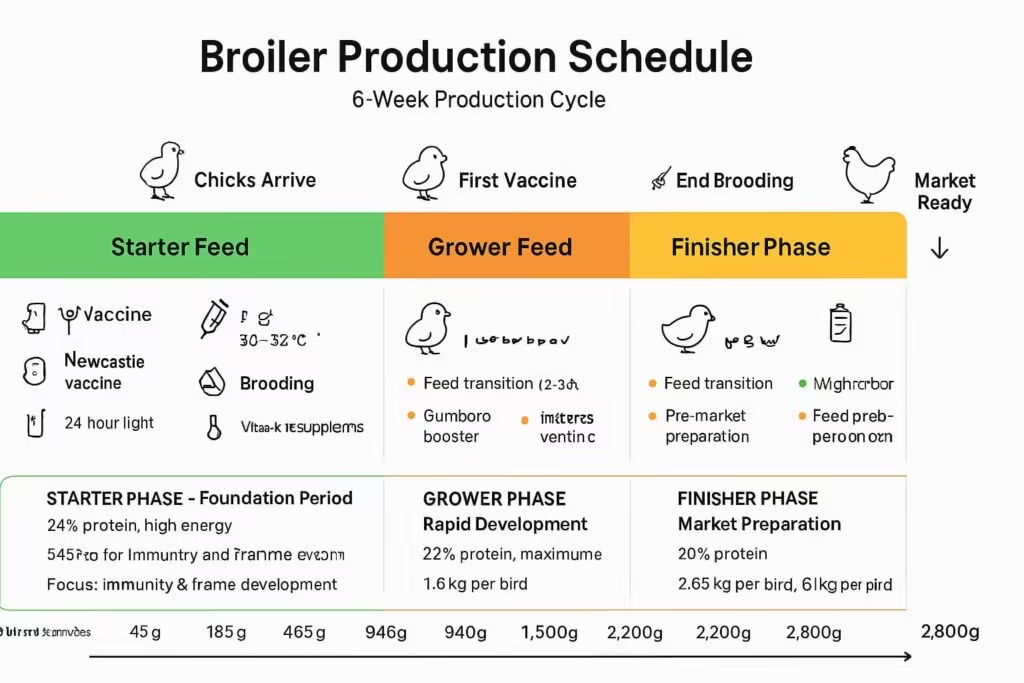
Factoring in Mortality and Water Consumption
When planning your feed purchase, it is important to factor in the reality of your flock. A typical mortality rate is around 3-5% over the 6-week period. To get a more accurate total, you can adjust your starting number of birds. For example, for a target of 100 surviving birds, you should buy 103-105 chicks initially. The feed calculations in this guide should be based on your current number of birds, accounting for any losses.
Furthermore, water is often overlooked. A healthy broiler will consume approximately 1.7 to 2 times the amount of water as feed. (This is an estimate.) This means for every kilogram of feed they eat, they need around 2 litres of fresh, clean water. Ensuring constant access to clean, cool water is non-negotiable and directly impacts feed intake and growth. Regular chicken health checks help you spot feeding-related issues early.
Seasonal Adjustments for Feed Consumption
Nigeria’s climate is split into two main seasons, and each presents a unique challenge for feed management. Adjusting your strategy based on the season is a sign of an experienced and profitable farmer.
- Dry Season (November – March): This season is characterized by high temperatures and low humidity, especially in the North. This leads to severe heat stress. Your birds will eat less and drink significantly more. You should focus on providing cool water and feeding during the cooler parts of the day, such as early morning (5-7 am) and late evening (7-9 pm). Leaving a low-wattage light on at night to encourage eating can be very effective.
- Rainy Season (April – October): The rainy season brings cooler temperatures but much higher humidity. While the cooler temperatures are more comfortable for the birds, the humidity can lead to damp litter, which increases the risk of diseases like Coccidiosis and can cause feed spoilage. The wet conditions can also increase the risk of internal parasites and worms in chickens. During this time, it is critical to ensure your poultry house has excellent ventilation and that the litter is kept dry.
Regional Climate Variations and Feed Management
While heat stress is a general problem in Nigeria, its effects can vary.
- Coastal and Southern Regions (e.g., Lagos, Port Harcourt): These areas have high humidity, which makes it harder for birds to cool down through panting. This can significantly reduce feed intake. In these regions, extra focus should be placed on ventilation and providing cool water.
- Northern and Inland Regions (e.g., Abuja, Kano): These areas can have very high daytime temperatures but lower humidity. While heat stress is still a concern, the cooler nights offer more opportunity for the birds to eat and recover. Farmers in these regions should still provide the bulk of the feed during the cooler morning and evening hours.
Tips to Reduce Feed Wastage and Save Money
Feed is expensive, and every grain wasted is lost profit.
- Don’t Overfill Feeders: Only fill feeders to about one-third full. If they are too full, the birds will spill a lot of feed onto the litter.
- Use Quality Feeders: Invest in feeders that are designed to minimize spillage.
- Feeder Height: Adjust the height of your feeders so the lip of the feeder is level with the birds’ backs. This makes it easy for them to eat but harder to spill.
- Control Pests: Rats and wild birds can eat a surprising amount of feed. Secure your pen and store your feed in a pest-proof location.
In summary, good management is just as important as good feed. By providing constant access to feed and water and minimizing wastage, you ensure every Naira you spend on feed counts. With these practices in mind, let’s put it all together and calculate the total cost.
Section 6: Cost of Feeding 100 Broilers in Nigeria (Detailed Analysis)
Based on current market prices, the estimated cost of feeding 100 broilers for a 6-week cycle in Nigeria is approximately ₦407,740. Now, here’s where it gets interesting. Let’s combine our calculations to find out what is the cost of feeding 100 broilers. This will help you create a realistic budget and answer the question how many bags of feed for 100 broilers will be enough.
Assumed Average Prices (Estimates):
- Starter Feed: ₦24,000 per 25kg bag
- Grower Feed: ₦20,000 per 25kg bag
- Finisher Feed: ₦21,500 per 25kg bag
Phase 1: Starter (Weeks 1-2)
- Bags Needed (Estimated): 2.16 bags (let’s calculate with this for accuracy)
- Cost: 2.16 bags × ₦24,000/bag = ₦51,840
Phase 2: Grower (Weeks 3-4)
- Bags Needed (Estimated): 6.4 bags
- Cost: 6.4 bags × ₦20,000/bag = ₦128,000
Phase 3: Finisher (Weeks 5-6)
- Bags Needed (Estimated): 10.6 bags
- Cost: 10.6 bags × ₦21,500/bag = ₦227,900
Total Estimated Cost for 100 Broilers:
- Total Bags (Estimated): 2.16 + 6.4 + 10.6 = 19.16 bags (so, 19 to 20 bags)
- Total Cost (Estimated): ₦51,840 + ₦128,000 + ₦227,900 = ₦407,740
So, the estimated cost of feeding 100 broilers in Nigeria for 6 weeks is approximately ₦407,740. A farmer in Lagos State with 100 birds would need to budget around this amount for feed alone. These feed costs should be incorporated into your complete poultry farming business plan for Nigeria.
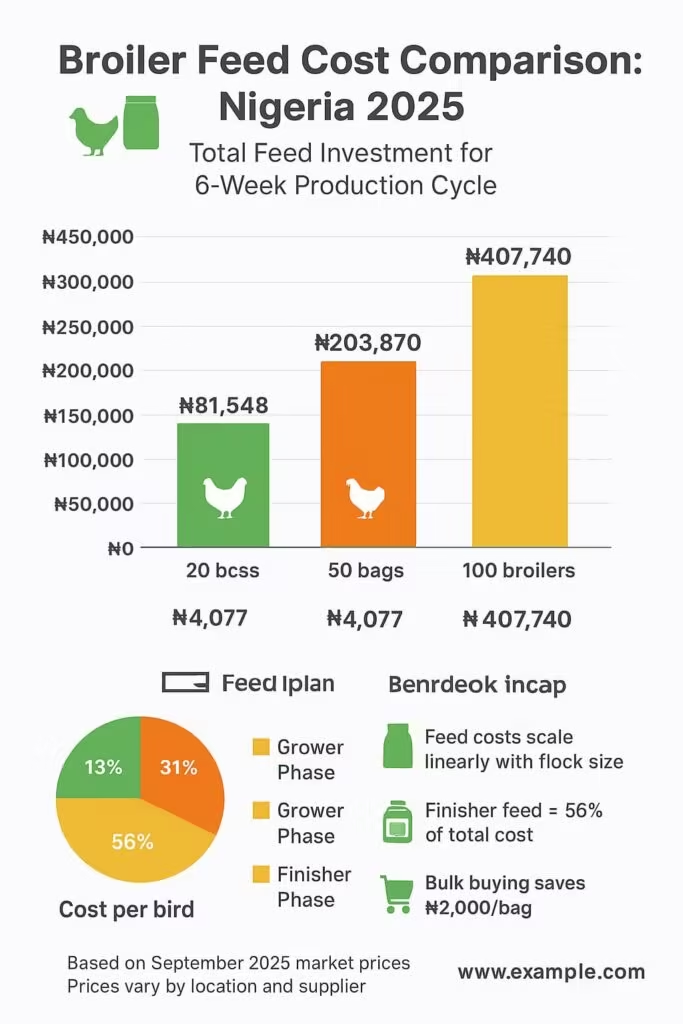
Cost-Saving Strategies: Bulk and Cooperative Purchasing
When buying feed, the price per bag is a major factor, but the size of your purchase can have an even bigger impact on your final profits. Suppliers often give significant discounts to farmers who buy in bulk. A single pallet can contain 20 bags, and a full truckload can contain 400-600 bags.
Since most small to medium-scale farmers do not need a full truckload of feed, a common and effective strategy in Nigeria is cooperative purchasing. This is when a group of farmers pools their money together to buy a large quantity of feed directly from the manufacturer or a major distributor. This strategy allows them to access the lower bulk price, even if their individual farms are small.
Calculation Example: Savings from Cooperative Purchasing This example uses estimated prices to demonstrate the potential savings. Let’s assume the average market price for a bag of broiler feed is ₦21,500. A large distributor offers a bulk price of ₦19,500 per bag for a full truckload of 500 bags. A group of 25 farmers (each raising 100 broilers) decides to buy a truckload together, with each farmer receiving 20 bags.
- Cost per Farmer (Individual Purchase):
- Total bags: 20 bags
- Cost: 20 bags × ₦21,500/bag = ₦430,000
- Cost per Farmer (Cooperative Purchase):
- Total bags: 20 bags
- Cost: 20 bags × ₦19,500/bag = ₦390,000
- Total Savings per farmer:
- ₦430,000 – ₦390,000 = ₦40,000
This calculation shows that by buying cooperatively, a single farmer can save a significant amount of money just on feed. This extra money is a direct increase to their profit margin.
Budgeting for More Than Just Feed
Remember, feed is your biggest expense, but it’s not your only one. When creating your budget, you must also account for:
- Cost of Day-Old Chicks
- Vaccines and Medications
- Bedding material (wood shavings)
- Heating/Brooding costs (charcoal or electricity)
- Labor and transportation
In summary, knowing your total feed cost is the largest piece of your financial puzzle. By budgeting for this amount, you are well on your way to a profitable venture. To wrap up, let’s answer some final questions you might have.
Section 7: Frequently Asked Questions (FAQ)
This section answers common questions from Nigerian poultry farmers, providing practical solutions to common challenges related to broiler farming. Here are answers to some common questions Nigerian poultry farmers ask.
1. Can I feed my broilers layer feed to save money?
No. This is a very bad idea. Layer feed has low protein and high calcium, designed for egg-laying. Feeding it to broilers will lead to extremely poor growth, weak bones, and you will lose a lot of money.
2. My birds are having watery droppings (diarrhoea). Is it the feed?
It can be. Sudden feed changes can cause this. It can also be a sign of poor water quality, heat stress, or a disease like coccidiosis. If it continues, consult a veterinarian.
3. How much space do my feeders and drinkers need?
Not enough space causes competition, and weaker birds won’t get enough to eat. A good rule is to have at least 2-3 tube feeders and 2-3 bell drinkers for every 100 birds.
4. What is the best way to store feed to prevent spoilage?
Store feed in a cool, dry, and well-ventilated area. Use pallets to keep bags off the floor and away from walls to prevent moisture. Never store feed near chemicals or in direct sunlight. Make sure the storage area is rat-proof and secure to prevent pests from contaminating the feed.
5. How do I know if my broilers are eating enough?
The most reliable way is to use the Standard Feeding Chart in Section 3 and monitor their weekly feed consumption against the targets. You should also observe their behavior; healthy, well-fed broilers are active, have a strong appetite, and will show consistent growth.
6. How do I know if I’m overfeeding chickens?
It’s generally difficult to “overfeed” broilers since their growth rate is so high. However, if you see a lot of feed wasted or spilled on the litter, or if your birds are showing signs of poor health despite high consumption, it could indicate an issue with feed quality or a health problem rather than overfeeding.
7. When to give broiler booster?
A broiler booster is not a standard part of the feeding program. The term is sometimes used to refer to a high-energy, medicated starter feed given to day-old chicks to give them a strong start. If you are starting a new flock, you can consider using this type of feed for the first few days, but it’s not a substitute for the proper broiler feeding phases.
8. How many bags of feed do I need for 500 layers?
This guide focuses on broilers, which are meat birds. Layers are for egg production and have different feed requirements and lifecycles. A layer requires about 0.09 kg of feed per day, and their total feed consumption will be much higher over their laying life (1.5-2 years). The calculations in this guide are not applicable to layers. For information on layer feed requirements, visit our guide on layer farming business in Nigeria.
Conclusion: Your Key to Profitable Broiler Farming
Understanding how many bags of feed for broilers you need is the foundation of a profitable poultry business in Nigeria. As we’ve seen, a flock of 100 broilers will typically consume about 19-20 bags of feed over 6 weeks, costing around ₦407,000 based on current prices.
By using the detailed calculations, the standard feeding chart for broilers, and the management best practices provided—especially managing for heat stress, local feed formulation, and reducing wastage—you can now confidently plan your budget, avoid costly mistakes, and ensure your birds grow healthy and fast.
Remember that these figures are a guide; always monitor your flock’s consumption and adjust as needed. With this knowledge, you are no longer guessing but making data-driven decisions for your farm’s success.

Oladepo Babatunde is the founder of ChickenStarter.com. He is a backyard chicken keeper and educator who specializes in helping beginners raise healthy flocks, particularly in warm climates. His expertise comes from years of hands-on experience building coops, treating common chicken ailments, and solving flock management issues. His own happy hens are a testament to his methods, laying 25-30 eggs weekly.
